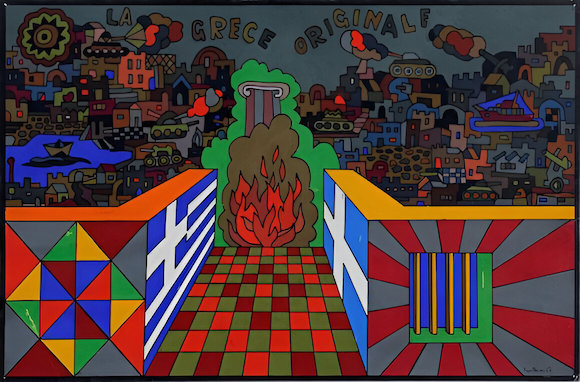Democracy – Exploring Greek Political History at the National Gallery of Athens
The Democracy exhibition at the National Gallery of Athens examines the relationship between politics and art.
The Democracy exhibition at the National Gallery of Athens examines the relationship between politics and art.
The relationship between art and politics is often compelling and complex. Throughout history, artists have used their works as vehicles to comment on turbulent times and advocate for political change. From July 2024 to February 2025, the National Gallery of Athens will host the remarkable Democracy exhibition.
Showcasing 140 works by 55 renowned artists from Greece, Portugal and Spain, the exhibition examines the links between art, tyranny, revolution, and the transition from authoritarian rule to democratic governance.
Democracy is a major exhibition unlike any other. The political, historical and philosophical nature of the exhibition makes it essential viewing for any serious art lover. This exhibition is the first time a collection of significant works from international artists has been brought together to represent the unstable period of Southern European history from the 1960s to 1970s.
Commemorating Southern Europe’s Turbulent History
It seems only fitting that the birthplace of democracy holds an art exhibition dedicated to the role of art in the struggle against authoritarianism. 2024 is a special year for Greece as it marks 50 years since the seven-year dictatorship of the Greek military junta was overthrown. In 1974, Greek citizens rose up against the authoritarian rule of the so-called Regime of the Colonels and eventually displaced the ruling junta.
However, Greece was not the only country undergoing massive political change at the time. Between 1974 and 1975, Portugal and Spain were both able to return to democratic states after years of authoritarian rule. Portugal’s Carnation Revolution in 1974 displaced the Estado Novo government while Spain was able to transition to democracy after the death of the fascist tyrant Francisco Franco Bahamonde in 1975.
The Democracy exhibition commemorates the significant political upheavals in Southern Europe during the middle of the 1970s. The exhibition features a collection of works from major Greek, Portuguese, and Spanish artists as well as contributors from across the globe. The conceptual core of the Democracy exhibition revolves around themes of revolution, oppression, tyranny, and the gradual transition from fascism to democratic governance.
In the words of Syrago Tsiara, Curator and Director of the National Gallery of Athens, “This exhibition serves as a testament to the struggles for civil liberties and the anti-colonial fight, offering a visual narrative of the quest for freedom against authoritarian regimes.”

Photo Credit: Thanos Kartsoglou
A Major Political Exhibition Like No Other
Curated by Director Syrago Tsiara, Democracy is a continuation of the previous exhibition, Urbanography, which featured artworks dealing with Southern European life in the decades after World War II.
A diverse range of artworks in a variety of mediums explores how people react to and resist political oppression and violence. The exhibition looks at how the artists of the period were inspired by the brutality of the dictatorial regimes and how new artistic methods were developed in the pursuit of civil liberties. The exhibition centres around four main themes: The Face of the Enemy, Resistance, Revolt, and Insurrection.
In total, 140 works from 55 artists are on display. The works encompass a variety of mediums including paintings, posters, films, projections, engravings, theatre, literature, and live performances.
Renowned artists such as Spain’s Manuel Calvo Abad, Colombia’s Fernando Botero, Alexis Akrithakis of Greece and the Portuguese artist Paula Rego are on display. Many of the works are on loan from major Spanish and Portuguese galleries such as the Museu d'Art Contemporani de Barcelona and the Museo Nacional Centro de Arte Reina Sofía as well as the Centro de Arte Moderna Gulbenkian and the Centro de Estudos Multidisciplinares Ernesto de Sousa. Other works were sourced from private collections in Greece and Portugal.
The Democracy exhibition also has a special programme dedicated to examining its subject matter in detail. The National Gallery of Athens is hosting a conference on the subject of the process of democratisation as well as various public lectures and workshops. Book presentations, debates, theatre performances, and film screenings are also being held.
The Democracy exhibition at the National Gallery of Athens is a must-see event for anyone who has an interest in the art, history, and politics of Europe.

Democracy at the National Gallery of Athens – Exhibition Details
The Democracy exhibition is being held in the central building of the National Gallery of Athens, Greece. Works will be on display from 11th July 2024 to 2nd February 2025.
Opening hours are from 10 am to 6 pm Mondays, Thursdays, Fridays, Saturdays and Sundays. The National Gallery of Athens is open from 12 pm to 8 pm on Wednesdays. The gallery is closed on Tuesdays.
Tickets for the exhibition are available online or at the gallery and are priced at €10 for a normal ticket and €5 for concession tickets.







